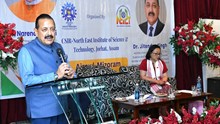
Farmers may soon be able to produce ammonia, a key fertilizer ingredient, directly on their farms using air and wind power. Researchers from Stanford University and King Fahd University of Petroleum and Minerals have developed a prototype device that generates ammonia, an essential fertilizer component, directly from the air using wind energy. This revolutionary method has the potential to replace the traditional Haber-Bosch process, which consumes 2% of global energy and accounts for 1% of annual carbon dioxide emissions due to its reliance on natural gas.
A study published in Science Advances highlighted the first field demonstration of this technology, conducted outside a laboratory setting. The researchers aim to eventually incorporate the device into irrigation systems, enabling farmers to produce fertilizer directly from the air.
The newly devised method operates at room temperature and standard atmospheric pressure, eliminating the need for high-energy inputs. By using a catalyst-coated mesh, the device extracts nitrogen from the air and hydrogen from water vapor, facilitating the ammonia production process. Unlike traditional techniques, it requires no external voltage source and is compact enough to be used on-site by farmers, reducing the need for transporting fertilizers from centralized manufacturers.
Laboratory tests demonstrated the potential to scale up the device. Researchers successfully recycled water using a spraying system, achieving ammonia concentrations suitable for hydroponic fertilizers in just two hours.
This efficient process shows promise for large-scale agricultural applications, and efforts are underway to expand the mesh systems to produce higher volumes of ammonia.
The implications of this innovation go beyond agriculture. Ammonia is an important clean energy carrier, making it crucial for decarbonizing industries such as shipping and power generation. Its higher energy density compared to hydrogen gas makes it a more efficient option for storing and transporting renewable energy. This makes this breakthrough a key component in the transition to sustainable energy solutions.
While the device is two to three years away from market readiness, the researchers are optimistic about its transformative potential.
With funding from the U.S. Air Force Office of Scientific Research and King Fahd University of Petroleum and Minerals, the project underscores ammonia’s importance in both agriculture and clean energy innovation.
(Source: Stanford University)
















